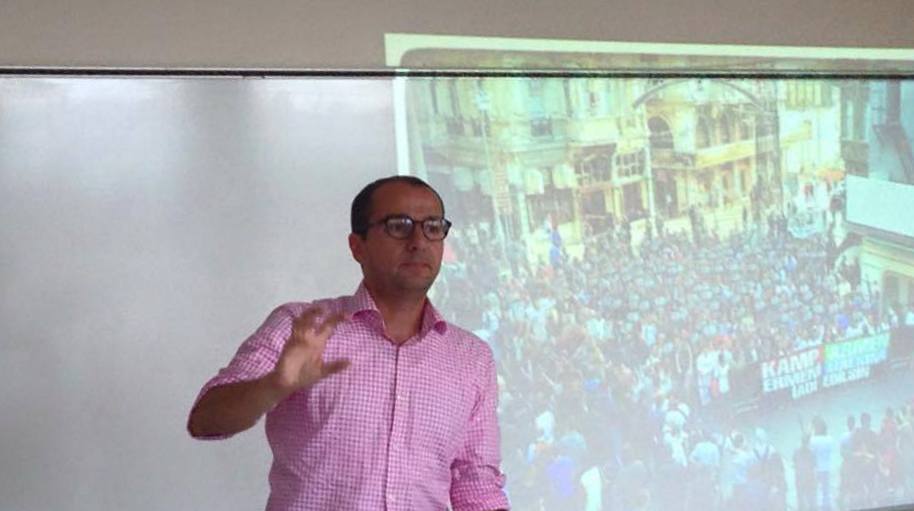By Michael Rettig
FRESNO, Calif. (Hye Sharzhoom)—As the Fall Semester draws to a close, students and professors reflect upon the lasting impact of the lessons they learned. With the current turmoil in Turkey and Syria as a backdrop, Dr. Khatchig Mouradian’s class on “The Armenian Genocide and its Aftermath” has provided a timely forum for students to learn about their past and its effect on modern issues.

“At the very core of my teaching philosophy is the hope that the study of history will help students better understand their own era and world, and ultimately be sensitized to racial, social, and economic inequality and injustice,” said Dr. Mouradian. Student, Raffi Apkarian, found this to be a crucial take-away from the class. “It is not just about the Armenians; we can look at the actions of the perpetrators and the repercussions of the genocide and recognize them in other events occurring around the world,” said Apkarian.
Dr. Mouradian began his class with an exploration of mass violence, imperialism, and colonialism in the 19th and 20th centuries. “We examined international law as it pertains to crimes against humanity and genocide, and then dived into Armenian life in the Ottoman Empire before World War I, the history of the Armenian Genocide, its aftermath, and finally a discussion on denial, resentment, the struggle for recognition, and justice.” Students were able to study Armenian life in different Ottoman provinces before the genocide using the website Houshamadyan.com. Many chose to focus on the province where their ancestors originated.
Dr. Mouradian added a more personal dimension to this lesson by showing the class photos from his travels in Western Armenian provinces now in the Turkish Republic. These photos resonated with many of the students who, although aware of their family stories, were unaware of the present conditions of their ancestral homeland and those who remained.
“It is one thing to hear stories about the homeland from family members, but seeing photos of the locations really brought it to life,” said sophomore, Alina Arakelian. Dr. Mouradian utilized these photos and other multimedia tools to enhance the learning experience. “When I teach, I am mindful that a picture is worth a thousand words, a video is worth a thousand pictures, and sometimes, curiously, a word is worth a thousand videos,” explained Dr. Mouradian.
Connecting the past to the present was a common thread throughout the class. Dr. Mouradian often incorporated stories from his travels in Turkey and the Middle East in his lectures to highlight how the history still affects the lives of not only Armenians, but Turks and Kurds as well. He told the class about his opportunity to speak at the first Armenian Genocide Commemoration in Aintab and how the Kurds in attendance were affected by the events of 1915.
Dr. Mouradian mentioned that Turks and Kurds often approached him in his travels and whispered in his ears that they had Armenian grandparents. “For many Armenians—including the Islamized, or “hidden” Armenians in Turkey—the Armenian Genocide is a current issue. They feel its implications on a daily basis, in their here and now. In class, we were particularly attentive to this, discussing, for example, the assassination of Hrant Dink, the challenges facing the Armenian community in Turkey, the Islamized Armenians and their struggles, and the impact of genocide denial on Armenian communities worldwide,” explained Dr. Mouradian.
“The Armenian Genocide and its Aftermath” allowed for students and professor to learn from each other in a collaborative setting. Dr. Mouradian encouraged his students to share their thoughts and engage in discussion on the issues.
Each class meeting would begin with a presentation from a student on a particular topic that they had chosen in the first week of class. Apkarian presented on the confiscation of property during the genocide. “I think it was my favorite topic because I found the process interesting and it correlated with the stories my grandparents told me about their experiences.”
The class provided a unique opportunity for students to understand the genocide in a more intimate way while sharing their own insights on the subject. It was not only a rewarding experience for the students, but for Dr. Mouradian as well.
“I firmly believe in the saying that the day a person stops teaching is the day a person stops learning. This class was no exception. My students’ insights and perspectives enriched my own understanding of genocide and the long shadow it casts over generations.”
Michael Rettig is the editor of Hye Sharzhoom, a supplement of The Collegian and the newspaper of the Fresno State Armenian Students Organization and the Armenian Studies Program. This article was first published in Hye Sharzhoom.
